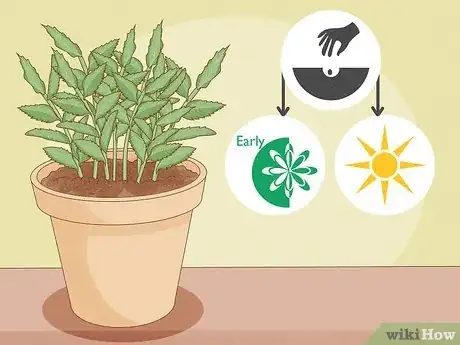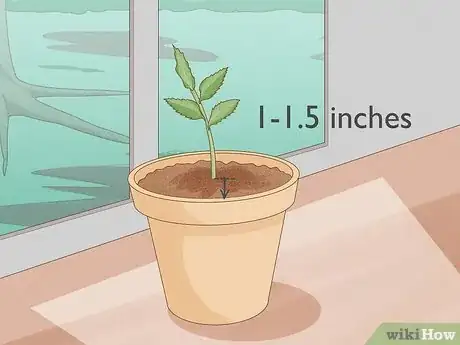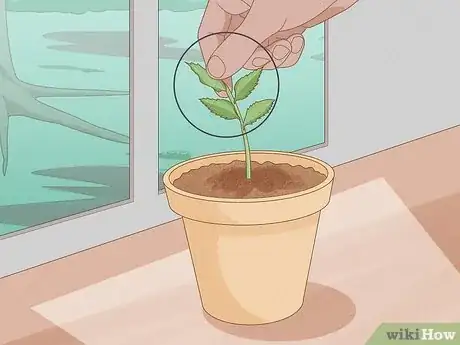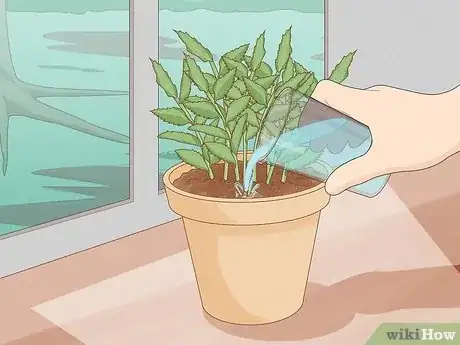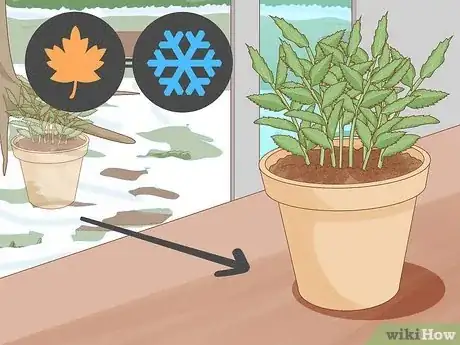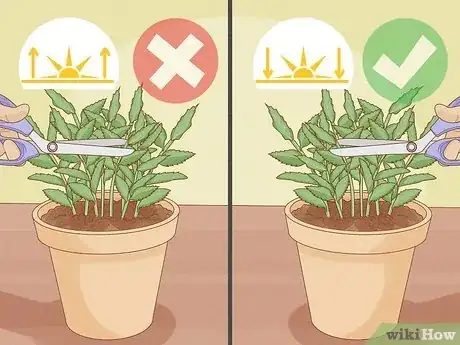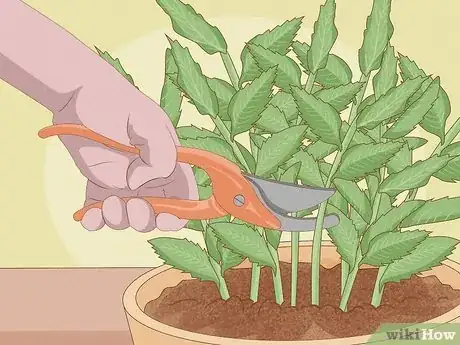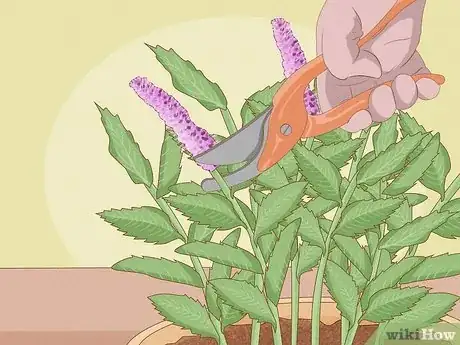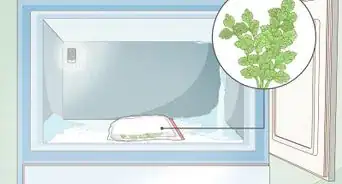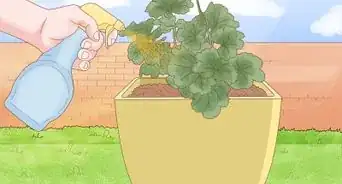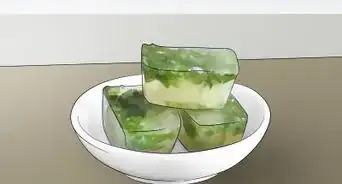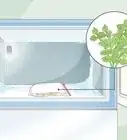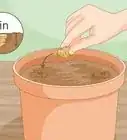This article was co-authored by Lauren Kurtz. Lauren Kurtz is a Naturalist and Horticultural Specialist. Lauren has worked for Aurora, Colorado managing the Water-Wise Garden at Aurora Municipal Center for the Water Conservation Department. She earned a BA in Environmental and Sustainability Studies from Western Michigan University in 2014.
There are 12 references cited in this article, which can be found at the bottom of the page.
This article has been viewed 64,051 times.
Vietnamese mint, also called "hot mint," is known for its peppery flavor and often used in soups or salad. Although this herb is native to tropical areas, it can be grown in most climates so long as you keep it warm and damp. This perennial herb can thrive indoors or in your garden for years if you grow it in the right conditions. Before you know it, you'll have plenty of Vietnamese mint to harvest.[1]
Steps
Planting Vietnamese Mint
-
1Plan to grow Vietnamese mint in the spring or summer. Vietnamese mint can be grown in most climates so long as they have warm, sunny weather. Avoid planting your mint in the fall or winter, if possible, and wait until the weather gets warmer in your area.
-
2Propagate Vietnamese mint from cuttings. Vietnamese mint is best grown from clippings. Purchase a Vietnamese mint plant from a nursery or grocery store. Cut a thick, healthy stem (about 6 inches (15 cm)) from the existing plant and pull off about 1/3 of the leaves. Place the cutting in a clean glass of water while it grows roots.[2]
- While clipping a stem from an existing Vietnamese mint plant, choose a segment with visible roots.
- Propagating the plant should take about 3-4 weeks.[3]
Advertisement -
3Transfer the cutting to a spot with partial shade. Although Vietnamese mint needs warm weather and sunlight, it will thrive best if it can get several hours of shade a day. Dig a hole about 1–1.5 inches (2.5–3.8 cm) deep, place the Vietnamese mint in the hole, and cover the roots with dirt.[4]
-
4Pinch out the plant's tips as you plant it into the ground. As your Vietnamese mint grows, you'll want it to develop thick, dense tips for the best flavor. To encourage leaf growth, pinch out the growing tip of the shoot as you put it in the dirt.[6]
Taking Care of the Plant
-
1Keep the soil surrounding the plant wet. The soil surrounding the plant should be consistently moist. Whenever you tend to your garden, place a finger in the soil. If the soil around your Vietnamese mint feels dry, water the soil until it feels damp. After watering your plant, apply fertilizer in a thin layer (or sprinkling, if you're using a liquid fertilizer) over the soil surrounding it.
- Because Vietnamese mint is known to grow in shallow water, overwatering the plant is usually not an issue.
-
2
-
3Prune Vietnamese mint regularly. If you do not cut back Vietnamese mint regularly, it can grow out of control and steal nutrients from other plants in your garden. Using a pair of garden shears, cut back any stems or leaves that are growing outside of the area you've set for the plant.
- Prune your Vietnamese mint at least once or twice monthly, or whenever you notice its long stems growing out of control.
- Pruning Vietnamese mint also keeps it bushy and growing vigorously.[10]
-
4Inspect your plant for aphids and spider mites. These are the two most common pests that Vietnamese mint deals with. If you spot the damage these pests can cause, spray your Vietnamese mint with a non-toxic insect repellent.[11]
-
5Bring Vietnamese mint indoors during the autumn and winter. Vietnamese mint grows best in warm weather and can die if the weather gets too cold. If you live in a cold climate or notice frost as the weather gets chilly, transfer your plant from your garden to a pot indoors.[14]
Harvesting Vietnamese Mint
-
1Wait a month before harvesting Vietnamese mint. After you've planted your cutting into your garden, you'll usually need to grow it for a month before you can harvest it. Harvesting any earlier can damage the cutting and won't likely result in thick, healthy sprigs.[15]
- The best time to harvest Vietnamese mint is in the late spring and summer, so plant your cutting at least one month before early summer.
-
2Harvest Vietnamese mint when the plant is dry. As a rule, the best time to harvest herbs is when they're dry. Dusk is usually ideal. If you're cutting Vietnamese mint in the morning, wait until the morning dew has evaporated.
- If you have a sprinkler system, keep its watering schedule in mind so you can water the Vietnamese mint before or several hours afterward.
-
3Cut a sprig with gardening shears. Whenever you need the mint leaves or notice the stems getting too long, snip off a sprig with a pair of shears. Vietnamese mint recovers well after being cut and grows back fairly fast.
- If you do not have gardening shears, a sharp pair of scissors can work as well.
-
4Remove the flowers as they grow. Vietnamese mint flowers are small and white, and they tend to grow in bunches. As you notice flowers growing on your plant, cut them off with your gardening shears.
- Taking the flowers off will help the plant conserve its energy for growing leaves, not flowers.
Community Q&A
-
QuestionWill a cutting of mint (without any roots) grow if I directly plant it into soil?
 Andy WinderCommunity AnswerIf your Vietnamese mint cutting does not have roots, it won't be able to establish itself into the soil. While propagating the plant, wait 3-4 weeks before planting it in your garden. This will ensure that it has enough roots to get water and nutrients from the soil.
Andy WinderCommunity AnswerIf your Vietnamese mint cutting does not have roots, it won't be able to establish itself into the soil. While propagating the plant, wait 3-4 weeks before planting it in your garden. This will ensure that it has enough roots to get water and nutrients from the soil. -
QuestionCan I grow it in the plastic green house? We have moderate climate so it would get more heat but would be in constant sunlight throughout the day (no shade in the greenhouse).
 Andy WinderCommunity AnswerYes, Vietnamese mint can grow in greenhouses. As long as it receives enough sunlight and remains in warm temperatures, your plant should thrive in this condition.
Andy WinderCommunity AnswerYes, Vietnamese mint can grow in greenhouses. As long as it receives enough sunlight and remains in warm temperatures, your plant should thrive in this condition. -
QuestionWhat is a good substitute for Vietnamese mint?
 NinoxTop AnswererBishop's weed (Houttuynia cordata) or Mushroom herb (Rungia klossii) are good substitutes for Vietnamese mint.
NinoxTop AnswererBishop's weed (Houttuynia cordata) or Mushroom herb (Rungia klossii) are good substitutes for Vietnamese mint.
Warnings
- Vietnamese mint can become an invasive plant if it's left to grow out of control. Take routine care of your mint to prevent this from happening. You can also prevent it from spreading by growing it in a contained spot, like a raised bed or a pot.⧼thumbs_response⧽
Things You'll Need
- Vietnamese mint cuttings
- Plant fertilizer
- Water
- Gardening shears
- Non-toxic insect repellent
References
- ↑ https://www.nurseriesonline.com.au/plant-index/herb-plants/vietnamese-mint/
- ↑ https://www.betterhealth.vic.gov.au/health/healthyliving/gardening-propagating-your-own-plants
- ↑ http://www.missouribotanicalgarden.org/gardens-gardening/your-garden/help-for-the-home-gardener/advice-tips-resources/visual-guides/rooting-cuttings-in-water.aspx
- ↑ https://www.nurseriesonline.com.au/plant-index/herb-plants/vietnamese-mint/
- ↑ https://www.stuff.co.nz/life-style/home-property/nz-gardener/71036369/how-to-grow-vietnamese-mint
- ↑ https://savvygardening.com/vietnamese-coriander/
- ↑ http://www.abc.net.au/gardening/stories/s1929589.htm
- ↑ https://savvygardening.com/vietnamese-coriander/
- ↑ https://www.nurseriesonline.com.au/plant-index/herb-plants/vietnamese-mint/
- ↑ http://www.abc.net.au/gardening/stories/s1929589.htm
- ↑ https://www.almanac.com/pest/aphids
- ↑ http://www.clemson.edu/extension/hgic/plants/vegetables/crops/hgic1311.html
- ↑ http://ipm.ucanr.edu/PMG/PESTNOTES/pn7405.html
- ↑ https://www.youtube.com/watch?v=4vQzBWZG6II&feature=youtu.be&t=195
- ↑ http://www.abc.net.au/gardening/stories/s1929589.htm
- ↑ https://www.nurseriesonline.com.au/plant-index/herb-plants/vietnamese-mint/
- ↑ http://www.sweetlivingmagazine.co.nz/growing-and-using-asian-herbs/
- ↑ https://www.1millionwomen.com.au/blog/how-to-propagate-mint/
